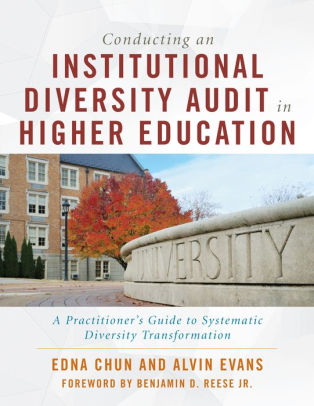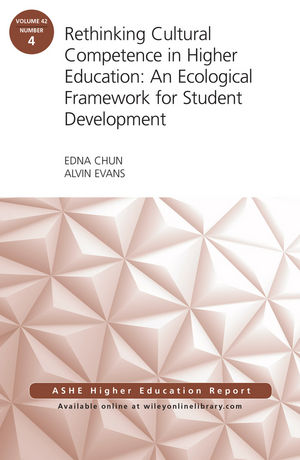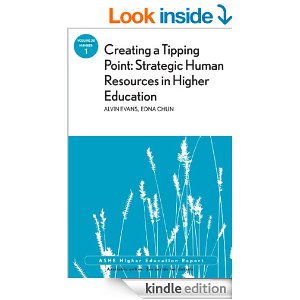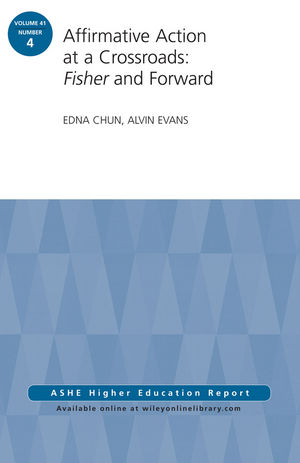Just published!
The Challenges of Minoritized Contingent Faculty in Higher Education

The Challenges of Minoritized Contingent Faculty in Higher Education offers a probing and unvarnished look at the employment challenges of these faculty members in four-year institutions. With dramatic shifts in the faculty workforce and nearly three-quarters of instructional positions in United States institutions now off the tenure track, contingent faculty have become the essential, frontline workers of higher education. Remarkably little research attention has focused on the experiences of minoritized contingent faculty in this new academic underclass. Based on in-depth interviews coupled with extensive research, the book highlights the double marginalization that can occur due to secondary employment status in the academic hierarchy, and the exclusion resulting from the intersectionality of nondominant social identities including race and ethnicity, gender, sexual orientation, gender identity, and disability. As the first-person narratives reveal, these faculty often struggle for acceptance, recognition, and rewards in the day-to-day academic environment, and they can face devaluation of their contributions. As a pragmatic and concrete resource, this book offers proactive workforce strategies and key structural and policy recommendations that will assist academic and administrative leaders, including presidents, provosts, department chairs, and chief diversity officers, in building more inclusive working conditions for contingent faculty.
Book Review in The Department Chair, Spring 2024
Edna Chun and Alvin Evans, two powerful and cogent voices in higher education, have written a compelling and timely book, The Challenges of Minoritized Contingent Faculty in Higher Education. It consists of six tightly organized chapters, with each logically leading to the next by providing context and first-person narratives that capture the reader’s interest. The book is well researched and well written and should serve as a framework that addresses the need for the development of enhanced contingent faculty working conditions. From this vantage point, chapter 6 includes practical strategies that colleges and universities can use to address the many issues raised in the book.
Chun and Evans interviewed numerous contingent faculty to obtain a real-time assessment of the many day-to-day challenges faced by these faculty. The introduction presents a sound overview of the current state of contingent faculty working conditions. The tenuous employment conditions of contingent faculty are discussed in light of the two-tiered faculty structure that currently exists throughout colleges and universities. The lack of employment security of contingent faculty is heightened by poor pay; absence of benefits; and a struggle for acceptance, recognition, and career stability. Importantly, the book highlights how the intersectionality of minoritized social identities, including race, gender, sexual orientation, gender identity, disability, age, class, and religion, can compound and intensify experiences of marginalization and exclusion for contingent faculty.
Chapter 1 presents an analysis of how and why the educational situation has morphed so persistently that the stability of tenured faculty employment is in danger. This imbalance has led to overreliance on contingent faculty as a less costly alternative for teaching students.
Chapter 2 presents extensive data tables that clearly identify major demographic trends in the relentless growth of contingent faculty coupled with the erosion of tenure-line positions.
Chapter 3 includes compelling and often heartbreaking interviews as shared by marginalized contingent faculty. The interviews cast a spotlight on the precarious working conditions of these faculty in terms of low pay, lack of health insurance, uncertain employment conditions, heavy workloads, differential treatment, and much more. I have also witnessed the pressure contingent faculty can face to “reward” students with higher grades to help ensure positive student evaluations to keep their position(s).
Chapter 4 focuses on resilient coping strategies of minoritized contingent faculty such as identifying organizational sponsorship and finding a support system (sponsor or mentor) within the institution. Personal narratives are sprinkled throughout this chapter.
Chapter 5 discusses how to navigate the distance between tenured and contingent faculty ranks within the dominant hierarchy present in institutions of higher education. The authors cite laws in Florida and Texas that have had a chilling effect on faculty governance and that undermine the basic tenets of higher education. After recognizing the increasing role of state officials impinging on the functions of public higher education, including pushback against diversity, equity, and inclusion, Chun and Evans offer specific signs of hope regarding a recalibration of the contingent faculty reward strategy: monetary compensation as well as nonfinancial rewards (e.g., fringe benefits, professional advancement, career development, and work-life balance).
Chapter 6 offers pragmatic recommendations for enhancing contingent faculty working conditions.
Contingent faculty are enormously important in helping realize the educational mission of universities and colleges. It is clear that contingent faculty will continue to play a leading role in student educational development given the prevailing prioritization of resources by decision-makers, budgetary constraints, and administrative preferences for flexibility and workforce control that have led to the progressive erosion of tenure-line positions.
The book concludes with specific concrete recommendations that not only bring to light the work and career perspectives of minoritized contingent faculty but also serve as a clarion call to administrators and faculty for the need to strengthen working conditions and build more inclusive cultures. This excellent book should be read by all institutional leaders, administrators, chairs, professors, students, and parents who are interested in understanding and addressing the many challenges of minoritized contingent faculty. A significant strength of this excellent book is that it does more than merely present the challenges faced by contingent faculty—it offers practical solutions to these challenges. ▲
Reviewed by Robert E. Cipriano, a former chair and professor emeritus of recreation and leisure studies at Southern Connecticut State University. Email: ciprianor1@southernct.edu
Transformational Music Teaching
by Edna B. Chun and George S.T. Chu – Palgrave Macmillan
https://link.springer.com/book/10.1007/978-3-031-38920-7

Leveraging Multigenerational Workforce Strategies in Higher Education
by Edna Chun and Alvin Evans
Routledge, April 15, 2021
 This book is the first to address the creation of multigenerational strategies in the higher education workplace based upon substantial empirical studies and qualitative research. Drawing on in-depth interviews with faculty and administrators, the book examines the broad “framing” of generations that consists of stereotypes, narratives, images, and emotions. Through the lens of these narratives, it describes how ageist framing is magnified by other minoritized statuses including race/ethnicity, gender, and sexual orientation, and can result in structural inequality, process-based discrimination, and asymmetrical behavioral interactions in the higher education workplace. A major feature of the book is its focus on best-in-class HR and diversity policies and strategies that institutional leaders can deploy to overcome generational and ageist barriers and build an inclusive culture that values the contributions of all members.
This book is the first to address the creation of multigenerational strategies in the higher education workplace based upon substantial empirical studies and qualitative research. Drawing on in-depth interviews with faculty and administrators, the book examines the broad “framing” of generations that consists of stereotypes, narratives, images, and emotions. Through the lens of these narratives, it describes how ageist framing is magnified by other minoritized statuses including race/ethnicity, gender, and sexual orientation, and can result in structural inequality, process-based discrimination, and asymmetrical behavioral interactions in the higher education workplace. A major feature of the book is its focus on best-in-class HR and diversity policies and strategies that institutional leaders can deploy to overcome generational and ageist barriers and build an inclusive culture that values the contributions of all members.
“As president of the No. 2-ranked university in the nation for conferring baccalaureate degrees to underrepresented students, I am a proponent of inclusive talent propositions that empower us to further diversify our educators to better serve our students. The arrival of Edna Chun and Alvin Evans’ new book, Leveraging Multigenerational Workforce Strategies in Higher Education, fills a long-vacant hole in this area of study with innovative strategies that will support higher education institutions overcome ageist barriers and develop multigenerational workforces that both reflect inclusive excellence and bolster student success.”
Fram Virjee, President, California State University, Fullerton
Conducting an Institutional Diversity Audit in Higher Education: A Practitioner’s Guide to Systematic Diversity Transformation
by Edna Chun and Alvin Evans, Routledge

Implementing systematic diversity transformation requires embracing all aspects of diversity—gender, sexual orientation, disability, gender identification, and other salient characteristics of difference—as well as race and ethnicity.
This book lays out a framework for systematic and sustained diversity process that first recognizes that too many diversity initiatives have generated more statements of intent than actual change, and that audits conducted by outside bodies frequently fail to achieve buy-in or long-term impact, and are costly endeavors. The authors’ framework identifies nine dimensions that need to be addressed to achieve a comprehensive audit that leads to action, describes the underlying research-based practices, and offers guidance on ensuring that all relevant voices are heard. The process is designed to be implemented by and within the institution, saving the considerable expense of outside consulting and design. In addition, it offers flexibility in the timing and sequence of implementation, and provides the means for each institution to interrogate its unique circumstances, context, and practices.
This book provides a concrete process for data gathering, analysis, and evaluation of institution-wide diversity efforts through a progressive, modular approach to diversity transformation. It provides campuses with the ability to audit, evaluate, and analyze diversity progress on the nine dimensions and prioritize areas of focus. Its systematic, research-based approach supports continuous improvement and proactively addresses accreditation criteria.
Rethinking Diversity Frameworks in Higher Education
by Edna B. Chun and Joe R. Feagin

With the goal of building more inclusive working, learning, and living environments in higher education, this book seeks to reframe understandings of forms of everyday exclusion that affect members of nondominant groups on predominantly white college campuses. The book contextualizes the need for a more robust analysis of persistent patterns of campus inequality by addressing key trends that have reshaped the landscape for diversity, including rapid demographic change, reduced public spending on higher education, and a polarized political climate. Specifically, it offers a critique of contemporary analytical ideas such as micro-aggressions and implicit and unconscious bias and underscores the impact of consequential discriminatory events (or macro-aggressions) and racial and gender-based inequalities (macro-inequities) on members of nondominant groups. The authors draw extensively upon interview studies and qualitative research findings to illustrate the reproduction of social inequality through behavioral and process-based outcomes in the higher education environment. They identify a more powerful systemic framework and conceptual vocabulary that can be used for meaningful change. In addition, the book highlights coping and resistance strategies that have regularly enabled members of nondominant groups to address, deflect, and counteract everyday forms of exclusion.
The book offers concrete approaches, concepts, and tools that will enable higher education leaders to identify, address, and counteract persistent structural and behavioral barriers to inclusion. As such, it shares a series of practical recommendations that will assist presidents, provosts, executive officers, boards of trustees, faculty, administrators, diversity officers, human resource leaders, diversity taskforces, and researchers as they seek to implement comprehensive strategies that result in sustained diversity change.
Leading a Diversity Culture Shift: Comprehensive Organizational Learning Strategies
Leading a Diversity Culture Shift in Higher Education offers a practical and timely guide for launching, implementing, and institutionalizing diversity organizational learning. The authors draw from extensive interviews with chief diversity officers and college and university leaders to reveal the prevailing models and best practices for strengthening diversity practices within the higher education community today. They complement this original research with an analysis of key contextual factors that shape the organizational learning process including administrative leadership, institutional mission and goals, historical legacy, geographic location, and campus structures and politics.
Leading a Diversity Culture Shift in Higher Education is a must-read for any higher education administration practitioner or scholar. The book masterfully weaves illuminating anecdotes with the latest state of the art scholarship to provide a primer on the major diversity-related issues facing higher education leadership today. It provides a blueprint for thinking about positive institutional change.
Robert M. Sellers, Ph.D., Vice Provost for Equity and Inclusion & Chief Diversity Officer, University of Michigan
Change, especially, cultural change is slow and hard in academia, but change we must. And in changing, we must embrace the demographic changes that are happening in our world and on our campuses. Leading a Diversity Cultural Shift in Higher Education with its rich case studies and analyses provides a roadmap for building a campus where everyone belongs.
Robert S. Nelsen, President, California State University, Sacramento
Rethinking Cultural Competence in Higher Education: An Ecological Framework for Student Development
ASHE Higher Education Report, 42(4)

Take a holistic look at an intentional educational ecosystem that builds cultural competence, a critical skill college graduates need for careers and citizenship in a diverse global society. This study unpacks the multilayered meanings of cultural competence and offers a term, “diversity competence,” that is more consistent with the broad spectrum of diversity learning outcomes that occur on campus.
Drawing on the findings of a survey of recent college graduates now working as professionals, the monograph offers:
- leading-edge, integrative models that bring together the multidimensional components of the learning environment including curricular, co-curricular, and service learning,
- research-based factors contributing to a campus environment that encourages cultural competence,
- in-depth assessment and analysis of best practices, and
- concrete recommendations that offer a transformative pathway to the attainment of diversity competence in the undergraduate experience.
Click here to purchase this book on Amazon.com
|
|
- concrete recommendations and strategies for the creation of a campus ecosystem that maximizes the structural, curricular, and interactional benefits of diversity,
- extensive empirical findings and a rich research literature,
- opportunities for campuses to craft programs, processes, and intervention that maximize student learning outcomes related to diversity, and
- alternative strategies for addressing disadvantage, including the use of socioeconomic status and state-based percent plans.
This book provides a comprehensive overview of key issues and strategic approaches that will assist institutions of higher education in fostering demographic diversity and building inclusive and welcoming campus environments.
The Department Chair as Transformative Diversity Leader: Building Inclusive Learning Environments in Higher Education
by Edna Chun and Alvin Evans

Edna Chun and Alvin Evans recognize the pivotal role that department heads and departments play in the structure, culture and climate of our colleges and universities. For diversity and inclusion efforts to really make progress, they must be nurtured and implemented at the grassroots level in each department where personnel decisions are made.”
– Santa J. Ono, President , University of Cincinnati
It is difficult for me to envision any authors more qualified than Edna Chun and Alvin Evans to address one of the most important topics in higher education today. They possess not only mature thinking and an investigative mindset, but their study is richly enhanced by department chair testimonials which provide personal insights and tried and true strategies to advance the diversity agenda. I recommend this splendid book without a single reservation to not only department chairs but deans and provosts who are, or should be, serious about building inclusive excellence in their institutions.”
– Walt Gmelch, former Dean and Professor of Leadership Studies , University of San Francisco
The academic chair stands at the crossroads of diversity transformation in higher education today. If higher education is to address the preparation of students for citizenship in a global, knowledge-based society, the role of the academic department chair in creating diverse and inclusive learning environments is arguably the most pivotal position in colleges and universities.
As the first research-based book devoted to the department chair’s diversity leadership role, this book draws upon an extensive survey and interview sample of department chairs throughout the United States to explore the ways in which chairs can influence and promote the success and progress of diverse faculty, staff, and students within the academic department. A particular area of focus in our study is on the differential experiences faced by chairs who are members of non-dominant groups in their efforts to promote diversity in a largely white male academic hierarchy. The book provides best practices and concrete strategies designed to assist presidents, provosts, deans, department chairs, administrators, chief diversity officers, and human resource professionals in enhancing the pivotal role of the academic department in diversity leadership.
Click here to purchase this book on Amazon.com. Also available directly from Routledge.
The New Talent Acquisition Frontier: Integrating HR and Diversity Strategy in the Private and Public Sectors and Higher Education
by Edna Chun and Alvin Evans

• Create the inclusive, high performance workforce needed to succeed in an increasing multicultural society and global marketplace
• Learn how global organizations and leading professional associations develop integrated HR/diversity talent strategies, and the specific challenges they face
• Get practical tools to assess integrated HR/diversity strategic planning, and see why organizations are not making more diversity progress
• Develop specific performance indicators to track your progress in implementing synergistic HR/diversity approaches
• Case studies of SHRM, federal and state government, global corporations, and higher education illustrate systematic, integrated HR/diversity efforts
For HR professionals and leaders, chief diversity officers, line managers, and executives in the private and public sectors and higher education, this book presents a systematic approach to integrating HR practices and strategic diversity initiatives to create the inclusive, high performance workforce that every enterprise and institution needs to succeed in an increasingly multicultural society and global marketplace.
The authors’ point of departure is that talent is the primary strategic asset necessary for organizational success in a demographically diversifying and globally interconnected world. Organizations must optimize their human capital resources by the deliberate development of synergy between human resource (HR) and diversity programs.
The authors identify two critical practices: talent management through the orchestration of HR and diversity programs to enhance organizational capability by unleashing, mobilizing, nurturing, and sustaining the contributions of a diverse workforce; and talent sustainability through the close integration of HR and diversity to continuously develop systems, structures, processes, and a culture that heighten employee commitment, engagement, and inclusion.
They further believe that there should be a commonality of practice across all types of organizations, so that each sector can learn from the others to accelerate its adaptation to today’s rapidly shifting national and global realities.
Edna Chun and Alvin Evans are award-winning authors and human resource and diversity. Two of their books, Are the Walls Really Down? Behavioral and Organizational Barriers to Faculty and Staff Diversity (2007) and Bridging the Diversity Divide: Globalization and Reciprocal Empowerment in Higher Education (2009) were recipients of the prestigious Kathryn G. Hansen Publication Award. Their most recent publications include Diverse Administrators in Peril: The New Indentured Class in Higher Education (2012) and Creating a Tipping Point: Strategic HR in Higher Education (2012). Alvin Evans serves as Interim Vice President of Human Resources for Kent State University and Edna Chun is Associate Vice Chancellor for Human Resources at the University of North Carolina at Greensboro.
Click here to purchase this book on Amazon.com. Also available directly from Jossey-Bass online.
Creating a Tipping Point: Strategic Human Resources in Higher Education
by Alvin Evans and Edna Chun

In a turbulent, unstable era of severe financial pressures, the development of strategic human resource (HR) practices has become an urgent mandate in higher education. With significant and widespread institutional shifts resulting from globalization, heightened competition, and rapid innovation, educational leaders must optimize their most significant resource—human capital—and align HR strategies, structures, and processes with organizational goals. Due to substantial cuts in state appropriations and rapidly diminishing budgets, public institutions of higher education in particular are struggling to realign resources and programs to fulfill their educational missions and maintain academic quality, while simultaneously responding to complex external legislative and accreditation mandates.
In light of these challenges, Creating a Tipping Point: Strategic Human Resources in Higher Education breaks new ground by presenting a research-based approach that supports the evolution of HR practices from siloed, transactional models to strategic operations that serve the entire university. This monograph provides a concrete, progressive road map to developing organizational capabilities in support of the university’s academic mission and illustrates this pathway with examples drawn from public research universities. It offers strategies, tools, metrics, and action steps that support the development of an effective and efficient strategic HR operation in higher education. For institutions seeking to implement strategic HR, this book is a practical and invaluable resource.
Click here to purchase this book on Amazon.com. Also available directly from Jossey-Bass online.
Diverse Administrators in Peril: The New Indentured Class in Higher Education
by Edna Chun and Alvin Evans

Diverse Administrators in Peril is the first in-depth examination of the work experiences of minority, female, and LGBT administrators in higher education. Written by two award winning practitioners in higher education, this vivid and intensive study of American leadership from the inside out illuminates how the collision between everyday life and systems of power takes place in patterns of subtle discrimination. Based on scores of interviews with diverse administrators, the book examines patterns of racism, sexism, and heterosexism that persist in the highest administrative ranks and provides concrete strategies and models for inclusive leadership practices.
From the Back Cover:
“This is an important book. Institutions of higher education in the United States stand at a crossroads. We face tremendous challenges: global competition, heightened expectations, reduced budgets, revolutionary technological changes, and new populations to serve. Yet for leaders who do not look like the expectations that other people have, there is often responsibility without authority. This is an ambitious effort to show how such individuals have adapted and succeeded, and it is much needed in today’s academy.”
-Chancellor Frank H. Wu,
University of California Hastings College of Law
“Barriers of discrimination, exclusion, and bias (both conscious and unconscious) must be replaced by inclusive and equitable practices. Chun and Evans provide troubling, but true, examples of current situations and excellent, clear recommendations for change.”
–Andy Brantley,
President and CEO, College and University
Professional Association for Human Resources
“Chun and Evans go where few educational researchers have dared to tread. . . . This pioneering study tells us much about the everyday administrative and social realities and human and personal costs of being a well-educated, high-achieving American who is not a straight white man.”
-From the Foreword by Joe R. Feagin
Click here to purchase this book on Amazon.com.
Bridging the Diversity Divide: Globalization and Reciprocal Empowerment in Higher Education
by Edna Chun and Alvin Evans
The sweeping forces of globalization present new challenges for higher education but also represent a clear mandate for change. Because of the unfinished business of remedying the underrepresentation of minorities and women in higher education, this book is designed to assist campus leaders and educators in the difficult process of cultural transformation in support of diversity and inclusion. The book explores the model of reciprocal empowerment as a moral framework linking the institution’s values, culture, and workplace practices to the outside world through the prism of diversity.
Bridging the Diversity Divide is a practical guide that provides concrete approaches to the creation of a genuinely inclusive campus. Its focus is on research-based strategies that will enable institutions of higher education to assess current practices, create successful action plans, and move beyond structural representation to true reciprocal empowerment. The measurement strategies, organizational learning tools, and best practices included here will assist institutions of higher education in building a flexible repertoire of institutional approaches to reciprocal empowerment and inclusion.
Only by systemic organizational change will universities bridge the diversity divide and create a campus culture that values and celebrates the contributions of all its members. This is a must-read for educators seeking to translate diversity principles into practice.This is the first issue in the 35th volume of the Jossey-Bass series ASHE Higher Education Report. Each monograph in the series is the definitive analysis of a tough higher education problem, based on thorough research of pertinent literature and institutional experiences. Topics are identified by a national survey. Noted practitioners and scholars are then commissioned to write the reports, with experts providing critical reviews of each manuscript before publication.
Click here to purchase this book on Amazon.com. Also available directly from Jossey-Bass online.
Are the Walls Really Down? Behavioral and Organizational Barriers to Faculty and Staff Diversity
by Alvin Evans and Edna Chun
 As higher education leaders seek to build and sustain a diverse workforce, the impact of subtle behavioral and organizational barriers hindering the success of women and minority faculty and administrators has been overlooked and is largely unrecognized. Written from a practitioner?s standpoint, this book is designed to help campus leaders detect and address the informal and formal barriers that still inhibit the hiring, promotion, and retention of women and minorities. It presents a cross-disciplinary framework for understanding the impact of contemporary forms of subtle discrimination, including emerging research on the psychosocial stresses on minorities and women.
As higher education leaders seek to build and sustain a diverse workforce, the impact of subtle behavioral and organizational barriers hindering the success of women and minority faculty and administrators has been overlooked and is largely unrecognized. Written from a practitioner?s standpoint, this book is designed to help campus leaders detect and address the informal and formal barriers that still inhibit the hiring, promotion, and retention of women and minorities. It presents a cross-disciplinary framework for understanding the impact of contemporary forms of subtle discrimination, including emerging research on the psychosocial stresses on minorities and women.
This award-winning issue examines the paradox of affirmative action efforts that have not been successful in altering institutional demographics over the last quarter century and explores the relationship between affirmative action and diversity. The monograph proposes a progressive model for inclusion based on the dynamic conceptual model of reciprocal empowerment. From a practical perspective, the monograph discusses current best practices in the field of diversity strategic planning and assessment using examples drawn from public research universities to create a systemic and systematic approach toward diversity and inclusion. For institutions seeking to improve their diversity initiatives, this book is definitely a step in the right direction.
An outstanding report from the ASHE series, and it is the winner of this year’s Kathryn G. Hansen Publication Award from the College and University Professional Association in recognition of its significant contribution in the field of human resource administration.
This is the first issue in the 33rd volume of the Jossey-Bass series ASHE Higher Education Report. Each monograph in the series is the definitive analysis of a tough higher education problem, based on thorough research of pertinent literature and institutional experiences. Topics are identified by a national survey. Noted practitioners and scholars are then commissioned to write the reports, with experts providing critical reviews of each manuscript before publication.
Click here to purchase this book on Amazon.com. Also available directly from Jossey-Bass online.



